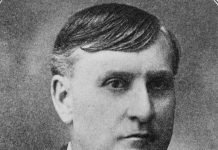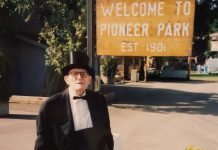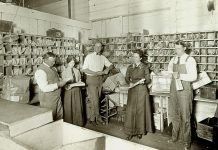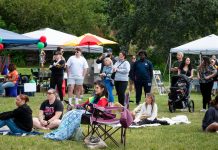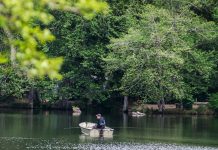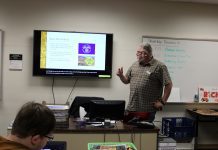Of the history books on Bellingham and surrounding towns, Lottie Roeder Roth’s 1926 “History of Whatcom County” is a foundational text still in use. As curious readers can discover, its author’s life and works are intertwined with the local history she documented.
Charlotte “Lottie” Roeder Roth (1864-1933) was the daughter of Henry Roeder – a Bellingham founder who started the first coal mine, Roeder-Peabody Mill, and Chuckanut Stone Quarry – and Elizabeth Roeder. She became a historian with the Daughters of the American Revolution and married Charles Roth, who bought the stone quarry. Lottie Roth avidly supported social causes through organizations such as Aftermath Club.
The family is most remembered for the Roeder Home, which Henry’s son Victor Roeder commissioned from architect Alfred Lee in 1903 to 1908 using Chuckanut sandstone from Roth Stone Quarry. Lottie Roth’s own history and “History of Whatcom County” demonstrates one founding message of Aftermath Club: “They talk about a woman’s sphere, as though it had a limit: There’s not a place on earth or heaven, There’s not a task to mankind given, There’s not a life, death, or birth, That had a feather’s weight of worth, Without a woman in it.”

Aftermath Club
Operating from 1895 to 2003, Bellingham’s Aftermath Club was one of many literary societies nationwide where women advocated for their roles in the public sphere. Susan Fahey’s 1994 study “A Quiet Region of the Mind” attributes the name to the “second gleaning” of lifelong learning.
Lottie Roeder Roth served as club historian for 15 years, starting in 1908. She described the camaraderie, “to understand another is one of Heaven’s richest blessings, and to be understood by another is a satisfying gift.”
“The Bellingham Herald” quoted Roth on Aftermath Clubhouse, constructed in 1904: “Since the first coal mined on the Pacific coast came from Bellingham Bay, since the first sawmill on the coast was built on Bellingham Bay, since the first brick building in the state was built here, it was appropriate that the first woman’s clubhouse in the state should be erected in what is now Bellingham. The Aftermath clubhouse has the distinction of being the oldest in the state.”
“History of Whatcom County” emphasizes the influence of women’s clubs. “Most of the early members of Aftermath Club are listed by Roth as members of other organizations in the area, often as founders and officers,” Fahey writes, including “the Music Club, the Bellingham Women’s Music Club, the Progressive Literary Fraternal Club, the Twentieth Century Club, the PEO Club, the Ladies’ Cooperative Society, the Women of Rotary, the Daughters of the American Revolution, and the Young Women’s Christian Association.”
Roth concluded her 1921-1922 club history, “What a pleasure it is to feel we are associated with so many capable women. The firm belief we have in each other strengthens each member. When it falls to their lot to entertain the others, that conviction of love and sympathy gives the required strength to carry forward what otherwise would be impossible.”

History of Whatcom County
Lottie Roeder Roth’s “History of Whatcom County” comprises two volumes: the first documenting historical events, the second influential people.
“This volume of ‘The History of Whatcom County’ is dedicated to the Spirit of the Pioneers,” Roth’s first volume opens, “not to any one of them, but to the Spirit of sturdy, steadfast honesty and industry and courage which pervaded them all and which we believe exists in the country today in the hearts and lives of its people.”
The first volume chronicles chapters such as the 1852 settlement, Fort Bellingham, Fraser Gold Rush of 1858, early coal mining, political development, railroads, rural towns’ emergence, Bellingham’s consolidation, and entrepreneurship until the time of writing.
“No Western story ever thrown upon the screen contains more thrills than does the actual history of Whatcom County,” Roth writes. “It was prefaced by the ‘Covered Wagon.’ Its background was California in the days of ’49. Its story is that of high adventure, both by land and sea. Upon its borders the history of Nations has been written. The romance of the mountains and of the forests is in its veins. It was written to the music of the waterfall and the ring of the woodsman’s axe.”

Other authors contributed chapters: Captain J.W. Tarte on seafaring, J.W. Edson on natural history, and Eva Lambert on the Lummi and other Native American groups. J.J. Donovan and Hugh Eldridge also reviewed the work.
Roth’s preface concludes, “This work is offered, not with the feeling that it is a complete or perfect volume, but in humble spirit, acknowledging the defects and limitations of what has been, nevertheless, an honest attempt to form a permanent and readable record of the county and home we love.”

Remembering Lottie Roeder Roth
Roth lends her name to two local landmarks: Lottie Street, which is accompanied by other streets named for the family (Henry, Elizabeth, Victor, and the Roeder surname) and Lottie Roth Block. Charles Fisher commissioned Elmer H. Fisher to construct the 1890 Chuckanut sandstone building. It has housed apartments since 1918 after supporting storefronts.
The Aftermath Clubhouse, sold in 1977, is now an event venue. Since 1971, Roeder Home has been a county park with scheduled tours.
As all these monuments are on the National Register of Historic Places, so is Lottie Roth’s “History of Whatcom County,” which is a monumental testament to its author and her family’s formative place in that history.






